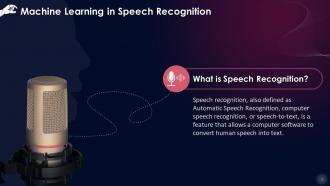Machine Learning For Speech Recognition Training Ppt
These slides discuss the fundamentals of speech recognition. It is a feature that allows computer software to convert human speech into text. They discuss the key features of a speech recognition system, algorithms, and a real-world use case.
You must be logged in to download this presentation.
 Impress your
Impress your audience
Editable
of Time
PowerPoint presentation slides
Presenting Machine Learning for Speech Recognition. These slides are 100 percent made in PowerPoint and are compatible with all screen types and monitors. They also support Google Slides. Premium Customer Support available. Suitable for use by managers, employees, and organizations. These slides are easily customizable. You can edit the color, text, icon, and font size to suit your requirements.
People who downloaded this PowerPoint presentation also viewed the following :
Content of this Powerpoint Presentation
Slide 1
This slide introduces Speech Recognition as an application of Machine Learning. It is a feature that allows a computer software to convert human speech into text.
Slide 2
This slide depicts the working of a speech recognition system. The three-step process includes signal level, acoustic level, and language level which converts an analog signal into transcription.
Slide 3
This slide lists the key features of an effective and efficient speech recognition system. These features include language weighting, acoustics training, speaker labeling, and profanity filtering.
Instructor’s Notes:
- Language Weighting: It can improve precision by weighting specific words that are frequently used, such as product names
- Acoustics Training: These ML driven systems pay attention to the acoustic part of the business. It trains the system to adjust to speaking styles (like voice pitch, volume, and pace) and acoustic environments (such as those seen in call centers)
- Speaker Labeling: These systems can create a transcription of a multi-participant conversation that references or tags each speaker's contributions
- Profanity Filtering: Filters can be used to identify specific words or phrases and cleanse the audio output
Slide 4
This slide depicts types of speech recognition algorithms. These include natural language processing, Hidden Markov Model, N-grams, neural networks, and speaker diarization.
Instructor’s Notes:
- Natural Language Processing: While Natural Language Processing (NLP) isn't strictly a specific method for speech recognition, it is a branch of Artificial Intelligence that focuses on human-machine interaction through languages, such as speech and text. Many mobile devices have speech recognition built in to conduct voice searches (e.g., Siri) or to improve messaging accessibility
- Hidden Markov Model: Hidden Markov Models allow us to add hidden events into a probabilistic model, such as part-of-speech tags. They are used as sequence models in speech recognition, assigning labels to each item in the sequence, such as words, syllables, phrases, etc. These labels create a mapping with the available input, allowing it to identify the most relevant label sequence
- N-Grams: This is the most basic language model, in which sentences or phrases are assigned probability. An N-gram is a collection of N words. For example, "Order the pizza" is a 3-gram phrase, while "please order the pizza" is a 4-gram phrase. Grammar and the probability of particular word sequences are used to increase recognition and accuracy
- Neural Networks: Training data is processed using neural networks, which use layers of nodes to replicate the interconnection of the human brain. Inputs, weights, a bias, and an output make up each node. If the output value reaches a certain threshold, the node is activated, and data is passed to the next tier of the network. Through supervised learning, neural networks learn this mapping function and then alter it using gradient descent based on the loss function
- Speaker Diarization: Speaker diarization algorithms recognize and segment speech based on the speaker's identity. This enables programs to discern between people in a discussion and is commonly used in contact centers to distinguish between customers and customer care executives
Slide 5
This slide showcases the IBM use case of Speech recognition driven by Machine Learning. Speech Recognition technologies and services allow IBM to automate complicated business operations while acquiring critical business insights.
Instructor’s Notes:
- IBM Watson Speech to Text: IBM Watson Speech to Text is a cloud-based solution that applies information about grammar, linguistic structure, and audio/voice signal composition to generate customized speech recognition for effective text transcription
- IBM Watson Text to Speech: IBM Watson Text to Speech delivers human-like audio from written text, expanding accessibility across languages and interaction modes and increasing customer engagement and happiness
Machine Learning For Speech Recognition Training Ppt with all 21 slides:
Use our Machine Learning For Speech Recognition Training Ppt to effectively help you save your valuable time. They are readymade to fit into any presentation structure.
-
Wonderful templates design to use in business meetings.
-
What an exhaustive collection of templates you guys have there in slideteam. Impressive!!!


















































